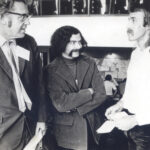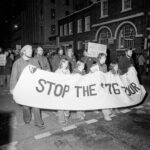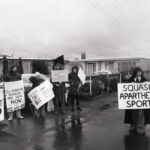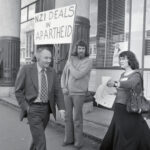Manawatu Exhibition: Anti-Apartheid
The whole world was watching
In 1981, the Springbok rugby team toured New Zealand. Protests against the tour were unprecedented. It was the closest New Zealand came to civil war in the 20th century. Over 56 days, more than 150,000 New Zealanders took part in demonstrations across the country. Twice a week, they marched. The target was not only the matches but hotels, transport companies and others who were facilitating the tour. Pitched battles were fought on rugby fields and in the streets. Two matches were cancelled. International news agencies sent crews to cover the developing story. The whole world was watching.
Manawatu Photographs
In March 1973 All Black Bob Burgess (Manawatū), recently returned from the All Blacks’ tour of the UK and France, was invited to speak to the Anti-Apartheid Conference in Wellington. He is on the right, talking to Tom Newnham from the Citizens’ Association for Racial Equality (CARE),
Palmerston North demonstrators marching against the All Blacks’ 1976 tour of South Africa. The tour went ahead, with the team arriving in South Africa shortly after the massacre of several hundred school pupils in Soweto. The students were protesting the introduction of Afrikaans as the language of instruction in schools. Because the New Zealand team had toured South Africa, 25 African nations boycotted the Montréal Summer Olympics.
Protesters at the entrance to the Palmerston North Squash Centre in Linton Street in 1977. Bill Barton is third from the left and Karen Sole holds the main banner. The Manawatū Standard rather pointedly commented that because of rain the protesters left before the South African squash team arrived. Also of historical interest is the sign directing drivers to the Bowling Club in Fitzherbert Avenue. It’s been decades since that bowling club was demolished. The site remains bare, with just a hint of the previously immaculate greens still visible.



